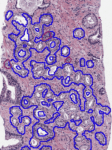Pathologists as a group are ambivalent about the prospect of artificial intelligence (AI) in pathology. Some are embracing the technology enthusiastically, and many others are concerned that it is a harbinger of the end of the specialty. In pathology forums, some med students have expressed concern about going into a “dying profession.” Will their time training be squandered because they’ve been rendered jobless 10 or 15 years from now? Many practicing pathologists are also wondering whether they need to contemplate a career change if AI becomes as disruptive as they fear.
What can AI actually do?
 AI can serve many functions in medicine, including clinical decision-making, as well as aiding in pre-analytic laboratory steps such as tissue grossing, tissue management, and innovative histology viewing. This discussion will focus on diagnostic algorithms of whole-slide images.
AI can serve many functions in medicine, including clinical decision-making, as well as aiding in pre-analytic laboratory steps such as tissue grossing, tissue management, and innovative histology viewing. This discussion will focus on diagnostic algorithms of whole-slide images.
For the last decade, AI diagnostic algorithms have been primarily focused on identifying prostate and breast cancer, as well as metastases to lymph nodes. These are understandable targets because they are commercially strategic, but are arguably easier to develop given that they are limited to cancer detection only and, in these specific settings, do not require deciphering oriented tissues, such as skin and mucosae. Having said that, some newer algorithms are beginning to identify a broader array of diagnoses, even in skin.
So what is AI best suited for? AI algorithms are ideal for screening massive quantities of image data and recognizing patterns (and patterns within patterns, etc.) that are associated with clinically relevant findings and/or diagnoses. Identifying “needle in a haystack” items is perfect for AI, such as finding rare AFB-positive organisms or a single cell with viral cytopathic effect. These algorithms can also discern low- and medium-magnification patterns that can differentiate various diagnoses, as with many dermatologic conditions.
Algorithms can also quantify much better than humans, providing accurate mitotic counts and percentages of IHC positivity, for example. Finally, AI has the capability to find morphologic correlations to some molecular aberrations. The hope is that at least some testing (e.g., immunohistochemistry, in-situ hybridization, and molecular tests) might be obviated by AI-based morphologic analyses alone.
What AI can’t do
Humans still have analytic skills that haven’t been replicated in silico. To begin with, AI algorithms cannot currently consider all the clinical and procedural information that accompanies a specimen to put the histologic findings into context, not to mention all the special study results performed on a given patient.
Next, to date, AI has not shown to be adept at analyzing tissues with suboptimal orientation, such as tangential cuts or twisted mucosae. Importantly, AI is simply not flawless and will often over-diagnose and under-diagnose.
And finally, it is my assertion that algorithm developers have no interest in assuming medical malpractice liability, meaning that they will likely only be interested in assisting pathologists in their tasks, and patients and surgeons, I believe, will be unwilling to rely solely on the AI software without confirmation from a board-certified pathologist.
Demographics favor the pathologist
The American Cancer Society estimated the U.S. had more than 1.9 million new cancer diagnoses in 2022. Due to population growth and aging demographics, these numbers will likely increase every year. And this aging of America will continue to produce huge volumes of surgical samples, due to cancer and all other diseases.
At the same time, according to a Fierce Healthcare article: “the number of U.S. pathologists decreased by nearly 18% between 2007 and 2017. During that time, the ‘diagnostic workload per pathologist’ rose by almost 42%.” They estimate that by the end of the next decade, there will be a deficit of more than 5,700 pathologists in the U.S.
My take: AI will save us. Here’s why:
The data in the previous paragraph indicate that pathologists are at a much higher risk of being overwhelmed with work than being replaced by AI. Further, the medico-legal implications of a pathologist-free diagnosis are untenable, in my opinion. So let’s embrace the help from AI that we so desperately need: to be productive, to be accurate, and to spend our time doing the more interesting aspects of pathology while AI does the tedious work.

